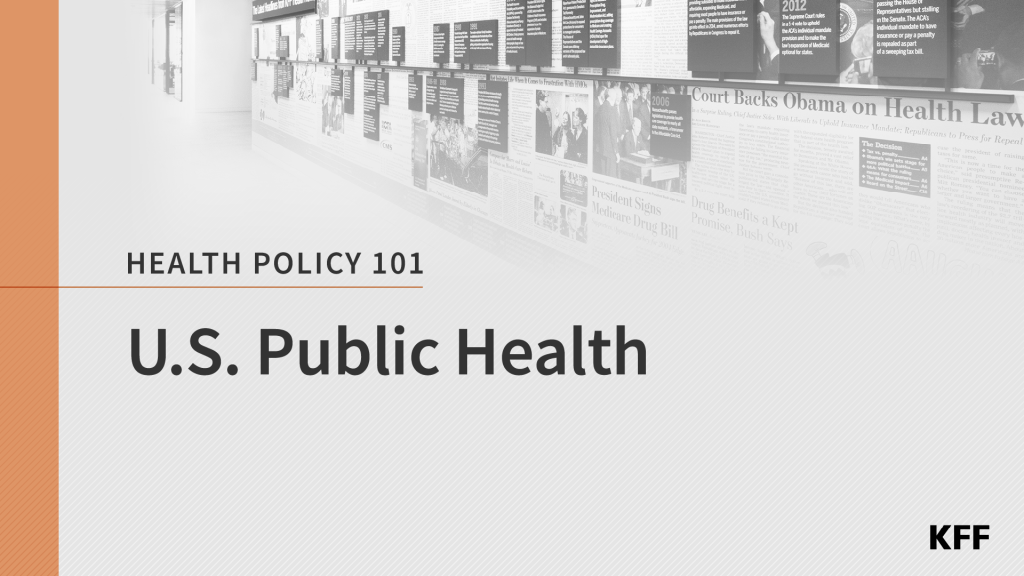Mpox One Year Later: Where is the U.S. today?
This brief provides an overview of the impact of mpox in the U.S. one year after a case of was identified domestically and the federal response to date, and discusses the future outlook.
The independent source for health policy research, polling, and news.
KFF’s policy research provides facts and analysis on a wide range of policy issues and public programs.
KFF designs, conducts and analyzes original public opinion and survey research on Americans’ attitudes, knowledge, and experiences with the health care system to help amplify the public’s voice in major national debates.
KFF Health News is a national newsroom that produces in-depth journalism about health issues and is one of the organization’s core operating programs.
Health Policy 101 is a comprehensive guide covering fundamental aspects of U.S. health policy and programs, including Medicare, Medicaid, the Affordable Care Act, employer-sponsored insurance, the uninsured population, health care costs and affordability, women's health issues, and health care politics. The Public Health chapter examines how public health is governed and delivered in the United States. It includes explanations of key public health frameworks, services, capabilities and characteristics, how the public health system works in state, local and territorial governments, and public health funding, workforce, and communication challenges in an era of declining trust.
This brief provides an overview of the impact of mpox in the U.S. one year after a case of was identified domestically and the federal response to date, and discusses the future outlook.
In response to the COVID-19 pandemic, the federal government declared numerous types of emergencies, Congress enacted several pieces of legislation, and various executive actions were taken and waivers issued, which established time-limited flexibilities and provisions designed to protect individuals and the health system during the pandemic. This resource provides a timeline identifying key health-related flexibilities and provisions specified by these various measures, the specific measure that determines their end date, and their end date.
Jen Kates, Senior Vice President and Director of KFF’s Global Health & HIV Policy program presented “The End of the Public Health Emergency Declaration for COVID-19,” at the 2023 Preparedness Summit on April 24.
A new KFF analysis finds that between 8 and 24 million people across the U.S. could be disenrolled from Medicaid during the unwinding of the program’s continuous enrollment provision. The estimates draw on data collected through KFF’s recent survey of state Medicaid and CHIP officials, conducted with the Georgetown University Center for Children and Families.
Between 8 and 24 million people across the U.S. could be disenrolled from Medicaid during the unwinding of the program’s continuous enrollment provision. KFF's new analysis offers three illustrative scenarios for how state-level Medicaid enrollment could decline between March 2023 and May 2024, ranging from 8 percent to 28 percent of total enrollees.
This analysis examines the impact of the COVID-19 pandemic by race and ethnicity through the lens of premature mortality, using the measures of premature mortality rate and years of life lost among excess deaths that occurred during the pandemic.
KFF hosted CDC Director Dr. Rochelle Walensky for a discussion focused on the status of COVID-19, the CDC’s priorities for the future, including the agency’s recent reorganization and other potential reforms, and how CDC is considering the health implications of climate change. Dr. Drew Altman, president and CEO of KFF, made introductory remarks. Dr. Jen Kates, senior vice president and director of KFF’s work on global health and HIV policy, moderated a discussion with Dr. Rochelle Walensky and Dr. Judy Monroe, CDC Foundation president and CEO, who discussed the future of public health as well as the role of public-private partnerships.
This survey examines Americans’ experiences with gun-related incidents such as being threatened with a gun, having a family member killed by a gun, or witnessing someone being shot. The survey also explores worries about gun violence, precautions people report taking to protect their families, how gun owners say they store their guns, and discussions about guns with health care providers.
Experiences with gun-related incidents are common across the country, with about one in five adults saying that they have personally been threatened with a gun (21%) or had a family member killed by a gun, including by suicide (19%), finds a new KFF survey about Americans’ experiences with gun-related violence and incidents.
More than three years into the COVID-19 pandemic, about half (53%) the public says they would likely get an annual COVID-19 vaccine if offered similar to an annual flu shot, the latest KFF COVID-19 Vaccine Monitor finds. This includes about a third (32%) who would be “very likely” to do so.
© 2025 KFF
